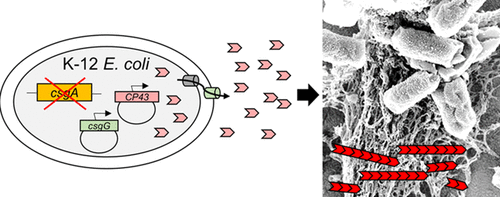当前位置:
X-MOL 学术
›
Biomacromolecules
›
论文详情
Our official English website, www.x-mol.net, welcomes your
feedback! (Note: you will need to create a separate account there.)
Engineered Escherichia coli Biofilms Produce Adhesive Nanomaterials Shaped by a Patterned 43 kDa Barnacle Cement Protein
Biomacromolecules ( IF 5.5 ) Pub Date : 2020-11-02 , DOI: 10.1021/acs.biomac.0c01212 Luis A Estrella 1 , Elizabeth A Yates 2 , Kenan P Fears 1 , Janna N Schultzhaus 3 , Heonjune Ryou 4 , Dagmar H Leary 5 , Christopher R So 1
Biomacromolecules ( IF 5.5 ) Pub Date : 2020-11-02 , DOI: 10.1021/acs.biomac.0c01212 Luis A Estrella 1 , Elizabeth A Yates 2 , Kenan P Fears 1 , Janna N Schultzhaus 3 , Heonjune Ryou 4 , Dagmar H Leary 5 , Christopher R So 1
Affiliation

|
Barnacles integrate multiple protein components into distinct amyloid-like nanofibers arranged as a bulk material network for their permanent underwater attachment. The design principle for how chemistry is displayed using adhesive nanomaterials, and fragments of proteins that are responsible for their formation, remains a challenge to assess and is yet to be established. Here, we use engineered bacterial biofilms to display a library of amyloid materials outside of the cell using full-length and subdomain sequences from a major component of the barnacle adhesive. A staggered charged pattern is found throughout the full-length sequence of a 43 kDa cement protein (AACP43), establishing a conserved sequence design evolved by barnacles to make adhesive nanomaterials. AACP43 domain deletions vary in their propensity to aggregate and form fibers, as exported extracellular materials are characterized through staining, immunoblotting, scanning electron microscopy, and atomic force microscopy. Full-length AACP43 and its domains have a propensity to aggregate into nanofibers independent of all other barnacle glue components, shedding light on its function in the barnacle adhesive. Curliated Escherichia coli biofilms are a compatible system for heterologous expression and the study of foreign functional amyloid adhesive materials, used here to identify the c-terminal portion of AACP43 as critical in material formation. This approach allows us to establish a common sequence pattern between two otherwise dissimilar families of cement proteins, laying the foundation to elucidate adhesive chemistries by one of the most tenacious marine fouling organisms in the ocean.
中文翻译:

工程化的大肠杆菌生物膜可产生由图案化的43 kDa藤壶水泥蛋白形成的粘性纳米材料
藤壶将多种蛋白质成分整合到截然不同的淀粉样纳米纤维中,这些纳米纤维被作为散装的材料网络进行永久性的水下附着。使用粘性纳米材料展示化学的设计原理以及负责其形成的蛋白质片段,仍然是评估的挑战,尚待建立。在这里,我们使用工程细菌生物膜,利用藤壶粘合剂主要成分的全长和亚结构域序列,在细胞外部显示淀粉样蛋白材料库。在43 kDa骨水泥蛋白(AACP43)的全长序列中发现了交错的带电模式,建立了由藤壶进化成的粘性纳米材料的保守序列设计。AACP43结构域缺失的聚集和形成纤维的倾向各不相同,由于出口的细胞外材料通过染色,免疫印迹,扫描电子显微镜和原子力显微镜来表征。全长AACP43及其结构域倾向于聚集成纳米纤维,而与所有其他藤壶胶水成分无关,从而减轻了其在藤壶胶中的作用。卷曲的大肠杆菌生物膜是用于异源表达和研究外源功能淀粉样粘附材料的兼容系统,此处用于鉴定AACP43的c末端部分对材料形成至关重要。这种方法使我们能够在水泥蛋白的其他两个不同家族之间建立通用的序列模式,从而为阐明海洋中最顽强的海洋污染生物之一奠定了基础。
更新日期:2020-11-02
中文翻译:

工程化的大肠杆菌生物膜可产生由图案化的43 kDa藤壶水泥蛋白形成的粘性纳米材料
藤壶将多种蛋白质成分整合到截然不同的淀粉样纳米纤维中,这些纳米纤维被作为散装的材料网络进行永久性的水下附着。使用粘性纳米材料展示化学的设计原理以及负责其形成的蛋白质片段,仍然是评估的挑战,尚待建立。在这里,我们使用工程细菌生物膜,利用藤壶粘合剂主要成分的全长和亚结构域序列,在细胞外部显示淀粉样蛋白材料库。在43 kDa骨水泥蛋白(AACP43)的全长序列中发现了交错的带电模式,建立了由藤壶进化成的粘性纳米材料的保守序列设计。AACP43结构域缺失的聚集和形成纤维的倾向各不相同,由于出口的细胞外材料通过染色,免疫印迹,扫描电子显微镜和原子力显微镜来表征。全长AACP43及其结构域倾向于聚集成纳米纤维,而与所有其他藤壶胶水成分无关,从而减轻了其在藤壶胶中的作用。卷曲的大肠杆菌生物膜是用于异源表达和研究外源功能淀粉样粘附材料的兼容系统,此处用于鉴定AACP43的c末端部分对材料形成至关重要。这种方法使我们能够在水泥蛋白的其他两个不同家族之间建立通用的序列模式,从而为阐明海洋中最顽强的海洋污染生物之一奠定了基础。











































 京公网安备 11010802027423号
京公网安备 11010802027423号